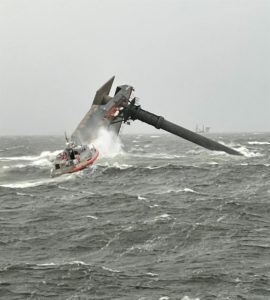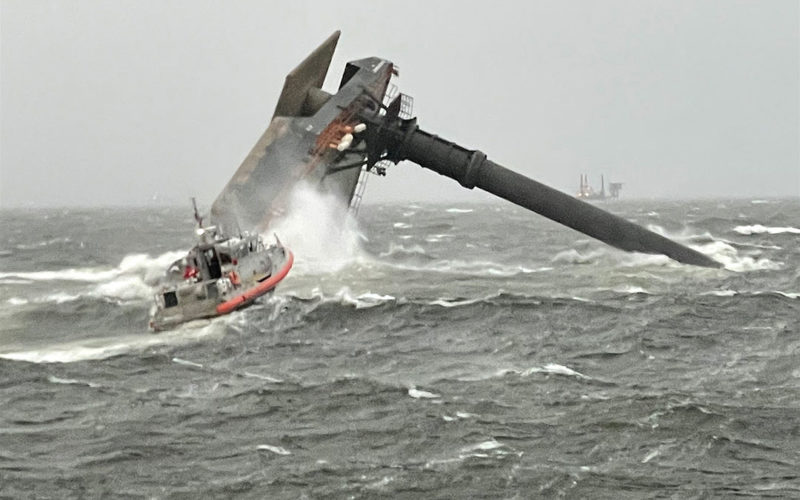
Five people died and eight others remain missing after a liftboat capsized in the Gulf of Mexico near Port Fourchon, La., after encountering hurricane-force winds while underway.
The 234-foot SEACOR Power rolled over at about 1630 on April 13, roughly 7 nautical miles from the port. The vessel came to rest on the seafloor partially submerged. Winds had exceeded 80 mph and seas were 7 to 9 feet in the area following a band of thunderstorms.
“That’s challenging under any circumstance,” said Capt. Will Watson, commander of Coast Guard Sector New Orleans. “We don’t know the degree to which that contributed to what happened, but we do know those are challenging conditions to be out in the maritime environment.”
Good Samaritan vessels rescued four people after the vessel rolled over, and the Coast Guard rescued two others. Five people were found dead in the days that followed the accident, and at press time eight people remained missing.
Authorities identified the victims as Capt. David Ledet, 63, of Thibodeau, La.; Anthony Hartford, 53, of New Orleans; James Wallingsford, 55, of Gilbert, La.; Ernest Williams, 69, of Arnaudville, La., and Lawrence Warren, 36, of Terrytown, La.
The cause of the accident is unknown and likely will remain that way for some time. The National Transportation Safety Board (NTSB) is leading the federal investigation, which could last up to two years.
SEACOR Marine of Houston owns and operates SEACOR Power, which was working under contract to Talos Energy of Houston. The vessel was about one month into a multi-month platform service project, according to John Gellert, SEACOR Marine’s president and CEO.
SEACOR Power left Port Fourchon at about 1330 on April 13 with nine crew and 10 contractors on board. It was bound for a Talos platform in Main Pass, roughly 25 nautical miles east of Port Fourchon. The vessel capsized onto its starboard side in roughly 55 feet of water.
It is not known what happened on the vessel or exactly what conditions it encountered. Video taken from other vessels operating in the area that afternoon showed intense, confused seas with strong winds and near-zero visibility.
SEACOR Power’s legs were lowered roughly 5 feet from their fully retractable position. Gellert said that “leads us to believe the captain was starting to jack down on position for safety.” Gellert said the legs typically lower at 5 feet per minute, suggesting Ledet began lowering them shortly before the vessel capsized.
SEACOR Power is a 265-class liftboat, meaning it has legs 265 feet long that can be lowered to the seafloor to lift the vessel out of the water to function as a floating platform. Its top speed underway is 4.3 knots.
Liftboats are required under federal regulations to be designed to withstand heavy weather. Most Gulf of Mexico liftboats, for instance, must be able to withstand winds of 70 knots (80.5 mph) while afloat and 100 knots (115 mph) while elevated in safe harbor, said David Bourg, managing partner of the naval architecture firm MiNO Marine in New Orleans.
“Liftboats having tall legs present relatively increased sail area and high center of mass,” said Bourg, who emphasized he was speaking in general terms and was not addressing SEACOR Power. “Generally, for ships, large sail areas and high centers of gravity are detrimental to afloat stability. That said, liftboats’ barge-like hulls tend to improve their stability characteristics.
“All these facts are accounted for in their design, the criteria by which their stability is measured, and their operations,” Bourg continued. “It’s a careful balance.”
Port Fourchon and surrounding areas were under a severe thunderstorm watch starting at 1206 on April 13. At 1427, the National Weather Service (NWS) issued the first of several special marine warnings forecasting strong thunderstorms and winds exceeding 34 knots (39 mph). These warnings were in effect until 1800.
NWS meteorologist Lauren Nash said a strong line of thunderstorms created a weather phenomenon known as a “wake low.”
“That is (what) happens on the back side of some of these strong lines of thunderstorms,” she said. “The air kind of rapidly sinks behind (the line) and creates very strong winds.” Wake lows typically last less than 10 minutes.
The victims’ friends and families have called into question the decision to sail from Port Fourchon. In a prepared statement, Talos Energy said the decision to leave port fell to the vessel’s captain and SEACOR, who had full control of the vessel.
When pressed by reporters at a news conference, Gellert said several times that the “go, no-go” decision rested entirely with the captain, but that SEACOR supported his decision to sail. It’s not clear if any records of these communications exist. One person rescued from the vessel was a senior crewmember who likely has knowledge of those discussions, Gellert said.
“The captain had almost 50 years of experience — he was a very veteran captain,” Gellert said. “He was one of our best captains and very prudent and conservative, so we were very confident he would not have gone out if he had any doubt whatsoever.”
Gellert added that weather conditions in the Gulf described by the Coast Guard far exceeded known forecasts for the area. “The weather they were forecast to encounter was well within the limits of the vessel, and the weather they ultimately encountered was well beyond the forecast, as far as we know,” he said.
Watson, the Coast Guard sector commander, said separately that conditions were more severe than anticipated.
The Coast Guard learned of the capsizing from a good Samaritan vessel. Unidentified commercial vessels operating in the area rescued four people soon after SEACOR Power rolled over. The Coast Guard cutter Glenn Harris, which had not yet been commissioned, arrived within 30 minutes and rescued one person. A 45-foot response boat from Station Grand Isle rescued another.
The Coast Guard led a massive search and rescue operation, often in trying conditions, that included state and local resources as well as numerous commercial vessels. The cutter Amberjack recovered a deceased person on April 14, and crew aboard the cutter Benjamin Dailey recovered another victim the following day. Donjon Marine divers recovered two people on April 16 and a fifth person was recovered April 18.
The Coast Guard suspended the search April 19. The operation via air and water covered more than 9,000 square nautical miles and lasted more than 175 hours, Watson said. Authorities have not released specifics on the rescues or where the bodies were recovered.
“The overriding factor (in suspending a search) is the time a person can survive given the conditions they are experiencing, in this case at sea, over a given time,” Watson explained. “In fact, we extended the search because we could not be certain, given the conditions out there, when someone might have entered the water.”
NTSB investigator Andrew Ehlers said the agency initially would explore three key areas: the people involved at sea and ashore; the vessel and its equipment; and the conditions on the day of the accident.
Other organizations that will assist with the investigation include the Coast Guard, the NWS and the American Bureau of Shipping. Ehlers said the NTSB is also seeking information from mariners who were on the water that afternoon, or who previously worked aboard SEACOR Power.
“People really are the heart of what we do, and it is why we focus on getting the answers right and making sure … we prevent an accident like this from happening again,” he said.

